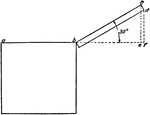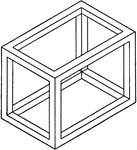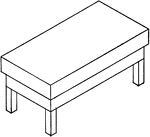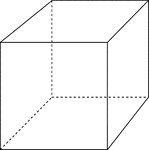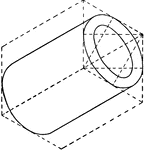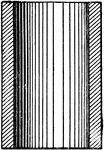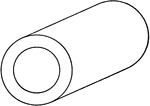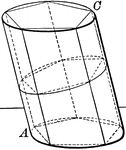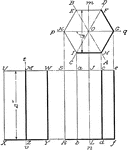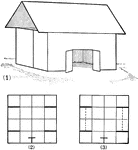
Pattern To Make A Barn
Illustration of pattern showing steps to make a barn. The barn is a composite figure made up of a triangular…

Development Exercise of Cone
Development and top completion exercise problem of the cone by dividing the base into equal parts and…

Development Exercise of Flange and Hood Cones
An exercise problem to complete the top and develop, stretched out, image of the flange and hood cones…

Development Exercise of Cylinder
An exercise problem in creating a development or rolled out surface of a cylinder in a 4" by 5" drawing…
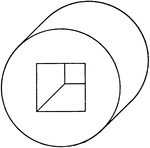
Oblique View Of Hollow Cylinder
Illustration of an oblique view of a hollow cylinder. The portion removed from the center of the cylinder…
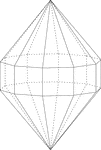
Elongated Decagonal Dipyramid
Illustration of an elongated decagonal dipyramid that is formed by elongating a decagonal bipyramid…

Elongated Decagonal Dipyramid
Illustration of an elongated decagonal dipyramid that is formed by elongating a decagonal bipyramid…

Elongated Decagonal Dipyramid
Illustration of an elongated decagonal dipyramid that is formed by elongating a decagonal bipyramid…

Elongated Heptagonal/Septagonal Dipyramid
Illustration of an elongated heptagonal/septagonal dipyramid that is formed by elongating a heptagonal…
Elongated Heptagonal/Septagonal Dipyramid
Illustration of an elongated heptagonal/septagonal dipyramid that is formed by elongating a heptagonal…

Elongated Heptagonal/Septagonal Dipyramid
Illustration of an elongated heptagonal/septagonal dipyramid that is formed by elongating a heptagonal…
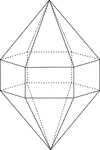
Elongated Hexagonal Dipyramid
Illustration of an elongated hexagonal dipyramid that is formed by elongating a hexagonal bipyramid…

Elongated Hexagonal Dipyramid
Illustration of an elongated hexagonal dipyramid that is formed by elongating a hexagonal bipyramid…
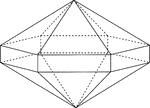
Elongated Hexagonal Dipyramid
Illustration of an elongated hexagonal dipyramid that is formed by elongating a hexagonal bipyramid…
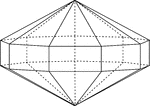
Elongated Nonagonal Dipyramid
Illustration of an elongated nonagonal dipyramid that is formed by elongating a nonagonal bipyramid…

Elongated Nonagonal Dipyramid
Illustration of an elongated nonagonal dipyramid that is formed by elongating a nonagonal bipyramid…
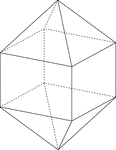
Elongated Square Dipyramid
Illustration of an elongated square dipyramid that is formed by elongating a square bipyramid by inserting…
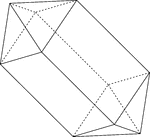
Elongated Square Dipyramid
Illustration of an elongated square dipyramid that is formed by elongating a square bipyramid by inserting…

Development Exercise of Dome and True Shape of Hip
A development or rolled out image exercise problem of the dome and finding the true shape of the hip,…

Development of Hexagonal Prism
An illustration of a hexagonal prism rolled out, or "stretched out" in the straight line AB.
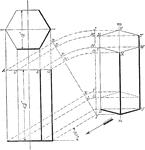
Projection Of Hexagonal Prism
Illustration of the projection of a hexagonal prism having two of its parallel sides parallel to the…
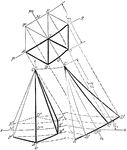
Projection Of Hexagonal Prism
Illustration of the projection of a hexagonal prism whose axis is parallel to the plane of the paper…

Development of Hollow Rectangular Prism
Pattern that can be used to make a hollow rectangular prism. Development of hollow rectangular prism.

Pattern To Make A House
Illustration of pattern showing steps to make a house. The house is a composite figure made up of a…

Development Exercise of Octagonal Light Shade
A problem exercise creating a stretched out or developed image of the octagonal light shade by using…

Plane Intersecting Octagonal Prism
Illustration showing the intersection of a plane with an octagonal prism.

Development Exercise of Octagonal Roof and True Shape of Rafter
Problem exercise in drawing a development or a stretchout image of the octagonal roof and finding the…

Equal and Parallel Opposite Faces of a Parallelopiped
Diagram used to prove the theorem: "The opposite faces of a parallelopiped are equal and parallel."

Parallelopiped with Plane Passing Through
Illustration of a parallelopiped with a plane passing through two diagonally opposite edges. The plane…

Parallelopiped with Plane Passing Through
Illustration of a parallelopiped with a plane passing through two diagonally opposite edges. The plane…
Parallelopiped Showing Volume
Illustration of a parallelopiped (a prism with a parallelogram as its base) used to demonstrate that…

Relationship Between 2 Parallelopipeds With Equal Altitudes
Diagram used to prove the theorem: "The rectangular parallelopipeds which have two dimensions in common…

Relationship Between Dimensions of Parallelopipeds
Diagram used to prove the theorem: "The rectangular parallelopipeds are to each other as the product…

Volume of Parallelopiped
Diagram used to prove the theorem: "The volume of a any parallelopiped is equal to the product of its…
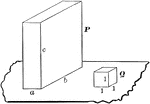
Volume of Rectangular Parallelopiped
Diagram used to prove the theorem: "The volume of a rectangular parallelopiped is equal to the product…

Prism
Illustration of a prism - a polyhedron of which two faces are equal polygons in parallel planes, and…

Pentagon Development Prism Exercise
An exercise developed to draw a rolled out or development of the pentagon prism in a 4" by 5" surface.
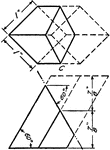
Pentagonal Prism Development Exercise
An exercise in drawing a pentagonal prism development or rolled out image in a 4" by 5" area.

Triangular Prism Development Exercise
An illustration to exercise a stretched out, or development, image of the triangular prism using 4"…

Triangle Prism Exercise
An illustration to draw triangle prism's development, or stretched out surfaces, in a 4" by 5" surface.

Prism Spectroscope from the Late 19th Century
"...a tube with a slit at the further end through which the light enters, and at the other end a collimating…

